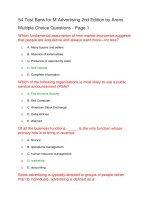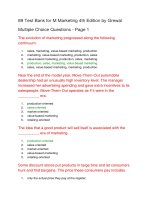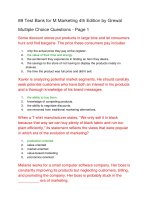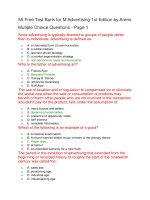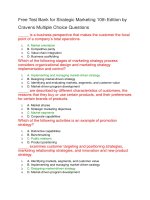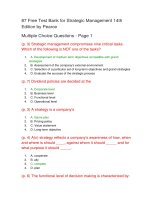Test bank for organic chemistry 7th edition by wade
Bạn đang xem bản rút gọn của tài liệu. Xem và tải ngay bản đầy đủ của tài liệu tại đây (824.59 KB, 30 trang )
Full file at />Organic Chemistry, 7e (Wade)
Chapter 1 Introduction and Review
1) While you were up late one night studying organic chemistry, you happened to see the last 5
minutes of an infomercial on TV. The spokesperson claimed that their brand of automobile tires
were superior to all other brands on the market because they were made by using only natural
rubber, isolated from the resin of rubber trees. How could a chemist test her claims that no
petroleum products went into the manufacture of her brand of tires?
Answer: Compounds synthesized from petroleum products have a lower content of 14C. Plantderived compounds are recently synthesized from CO2 in the air and have a higher 14C content.
Diff: 2
Section: 1.1
2) The atomic number of boron is 5. The correct electronic configuration of boron is:
A) 1s22s3
B) 1s22p3
C) 1s22s22p1
D) 2s22p3
E) 1s22s23s1
Answer: C
Diff: 1
Section: 1.2
3) How many distinct p orbitals exist in the second electron shell, where n = 2?
A) 2
B) 3
C) 4
D) 5
E) 6
Answer: B
Diff: 1
Section: 1.2
4) The __________ tells us that each orbital can hold a maximum of 2 electrons.
A) aufbau principle
B) Pauli exclusion principle
C) Hund's rule principle
D) LeChatelier principle
E) uncertainty principle
Answer: B
Diff: 1
Section: 1.2
buy this full document at
Full file at />5) Orbitals which are equal in energy are referred to as __________.
A) degenerate
B) polar
C) nodes
D) filled
E) nonpolar
Answer: A
Diff: 2
Section: 1.2
6) A node is a region of high electron density between the two atoms in a covalent bond.
Answer: FALSE
Diff: 1
Section: 1.2
7) When filling two or more orbitals of the same energy with electrons, the electrons will go into
different orbitals rather than pair up in the same orbital.
Answer: TRUE
Diff: 1
Section: 1.2
8) In a carbon atom, the 2s and 2p orbitals are equal in energy.
Answer: FALSE
Diff: 2
Section: 1.2
9) Atoms with the same number of protons but different numbers of neutrons are called
__________.
Answer: isotopes
Diff: 1
Section: 1.2
10) The electron density of __________ orbitals has spherical symmetry.
Answer: s
Diff: 1
Section: 1.2
buy this full document at
Full file at />11) Draw the line energy orbital diagram for the outer shell of an uncharge nitrogen atom and
describe the location and number of unshared electrons.
Answer:
There are three unshared electrons in Shell 2 and they are located in the three degenerate atomic
p orbitals.
Diff: 1
Section: 1.2
12) An oxygen atom has __________ valence electrons.
Answer: 6
Diff: 1
Section: 1.2
13) Which element in the second row of the periodic table has six valence electrons and a
valence of two?
Answer: oxygen
Diff: 1
Section: 1.2
14) The element with the electronic configuration 1s22s22p63s1 is __________.
Answer: sodium
Diff: 2
Section: 1.2
15) Provide the electron configuration of phosphorus.
Answer: 1s22s22p63s23p3
Diff: 2
Section: 1.2
16) Draw the shape of a 2p orbital.
Answer:
Diff: 2
Section: 1.2
buy this full document at
Full file at />17) Provide a Lewis structure for a molecule with molecular formula CH2O2.
Answer:
Diff: 2
Section: 1.4
18) Draw the Lewis structure for 2-butanol, CH3CH(OH)CH2CH3.
Answer:
Diff: 2
Section: 1.4
19) Draw the Lewis structure of acetic acid, CH3CO2H.
Answer:
Diff: 2
Section: 1.4
20) Draw a correct Lewis structure for chloromethane, CH3Cl.
Answer:
Diff: 1
Section: 1.4
buy this full document at
Full file at />21) Draw a correct Lewis structure for boric acid, B(OH)3.
Answer:
or
Diff: 2
Section: 1.4
22) Draw a correct Lewis structure for tert-butyl alcohol, (CH3)3COH.
Answer:
Diff: 2
Section: 1.4
23) Draw a correct Lewis structure for acetonitrile, CH3CN.
Answer:
Diff: 2
Section: 1.4
24) Draw a proper Lewis structure for H2SO4.
Answer:
Diff: 2
Section: 1.4
buy this full document at
Full file at />25) Write a Lewis structure for a compound with the molecular formula H2N2.
Answer:
Diff: 2
Section: 1.4
26) A carbon-hydrogen bond in ethane (CH3CH3) is best described a __________.
A) highly polar
B) essentially nonpolar
C) ionic
D) a multiple bond
E) resonance stabilized
Answer: B
Diff: 1
Section: 1.6
27) The electronegativity of elements on the periodic table increases going __________ a
column and to the __________ in each row.
A) up, right
B) up, left
C) down, right
D) down, left
Answer: A
Diff: 1
Section: 1.6
28) The compound methylamine, CH3NH2, contains a C
bond.
N In this bond, which of the
following best describes the charge on the carbon atom?
A) +1
B) slightly positive
C) uncharged
D) slightly negative
E) -1
Answer: B
Diff: 3
Section: 1.6
29) Within a given row of the periodic table, electronegativity typically increases left to right
across the row.
Answer: TRUE
Diff: 1
Section: 1.6
buy this full document at
Full file at />30) Covalent bonds may be polar or nonpolar. What property of the atoms forming a given bond
determines this?
Answer: Electronegativity
Diff: 2
Section: 1.6
31) The formal charge on oxygen in dimethyl ether, CH3OCH3, is:
A) +2
B) +1
C) 0
D) -1
E) -2
Answer: C
Diff: 1
Section: 1.7
32) The formal charge on nitrogen in the compound below is __________.
A) +2
B) +1
C) 0
D) -1
E) -2
Answer: B
Diff: 2
Section: 1.7
buy this full document at
Full file at />33) Which of the following are correct Lewis structures, including formal charges, for nitric acid,
HNO3?
A) A only
B) B only
C) C only
D) both B and C
E) A, B, and C
Answer: B
Diff: 3
Section: 1.7
34) For most compounds in which a nitrogen atom bears no formal charge, the valence of this
nitrogen atom is __________.
Answer: 3
Diff: 1
Section: 1.7
35) Assign the correct formal charge to each nitrogen atom in the following Lewis structure.
Answer:
Diff: 2
Section: 1.7
buy this full document at
Full file at />36) Add the appropriate formal charge to each atom in the molecule below. It is not necessary to
indicate formal charges when zero.
Answer:
Diff: 2
Section: 1.7
37) Add the appropriate formal charge to each atom in the molecule below. It is not necessary to
indicate formal charges when zero.
Answer:
Diff: 2
Section: 1.7
buy this full document at
Full file at />38) One or more of the atoms in the structure shown should have nonzero formal charges.
Redraw the structure and indicate any such charges.
Answer:
Diff: 2
Section: 1.7
39) One or more of the atoms in the structure shown should have nonzero formal charges.
Redraw the structure and indicate any such charges.
Answer:
Diff: 3
Section: 1.7
buy this full document at
Full file at />40) In the compound sodium methoxide (NaOCH3), there is __________ bonding.
A) ionic
B) polar covalent
C) nonpolar covalent
D) a mixture of ionic and covalent
E) resonance stabilized
Answer: D
Diff: 1
Section: 1.8
41) Which of the following compounds are covalent compounds?
A) KCl
B) CF4
C) NH3
D) both A and B
E) both B and C
Answer: E
Diff: 2
Section: 1.8
42) Which of the following bonding patterns of carbon is not allowed in the formation of an
organic compound?
Answer: f
Diff: 2
Section: 1.8
buy this full document at
Full file at />43) Which of the following choices represent(s) a pair of resonance forms?
A)
B)
C)
D) both A and C
E) both B and C
Answer: E
Diff: 3
Section: 1.9
44) Structures __________ , shown below, are resonance structures, and structure __________ is
the major contributor to the overall resonance hybrid.
A) 2 & 4; 2
B) 1, 3 & 5; 3
C) 4 & 6; 6
D) 1, 3 & 5; 1
E) 1, 3, 4 &5; 3
Answer: B
Diff: 3
Section: 1.9
buy this full document at
Full file at />45) When a negatively charged species is most appropriately depicted as a hybrid of several
resonance forms, the negative charge present is considered to be rapidly moving between the
resonance forms bearing the formal negative charge.
Answer: FALSE
Diff: 1
Section: 1.9
46) When a molecule can best be represented as a series of resonance forms, each of these forms
always contributes to the same degree in the hybrid.
Answer: FALSE
Diff: 1
Section: 1.9
47) Which of the following structures (a-d) is another resonance structure of the following
organic molecule?
Answer: b
Diff: 2
Section: 1.9
buy this full document at
Full file at />48) One resonance structure of a cation is shown. Provide the other reasonable resonance
structures.
Answer:
Diff: 2
Section: 1.9
49) Nitroamines are common functional groups found in energetic materials, such as RDX and
HMX. For the structure below, draw two other significant resonance structures, include any
formal charges, and indicate the hybridization on each nitrogen and oxygen.
Answer: All nitrogen and oxygen atoms are sp2 hybridized.
Diff: 3
Section: 1.9
buy this full document at
Full file at />50) Draw the important resonance forms of:
Answer:
Diff: 2
Section: 1.9
51) Draw the other important resonance form of:
Answer:
Diff: 3
Section: 1.9
52) Draw the important resonance forms for the structure shown below.
Answer:
Diff: 3
Section: 1.9
buy this full document at
Full file at />53) Draw the important resonance forms for the structure shown below.
Answer:
Diff: 3
Section: 1.9
54) Draw the important resonance forms for the structure shown below.
Answer:
Diff: 3
Section: 1.9
55) Which of the following condensed formulas represents the same compound as the line-angle
structure shown?
A) CH3CH2CH2OCH2CH2CH2N(CH2CH2CH3)2
B) CH3CH2CH2OCH2N(CH2CH3)2
C) CH3CH2OCH2N(CH2CH3)2
D) CH3CH2OCH2N(CH2CH2CH3)2
E) CH3ON(CH3)2
Answer: C
Diff: 2
Section: 1.10
buy this full document at
Full file at />
56) Indicate the line-angle structure that corresponds to the condensed structure,
HOCH2C(O)CH(CH3)2.
A)
B)
C)
D)
Answer: A
Diff: 2
Section: 1.10
57) Draw a line-angle formula for (CH3)2CHCH2CH2NH2.
Answer:
Diff: 1
Section: 1.10
58) A condensed structure for acetone is CH3COCH3. Provide the structural formula for
acetone.
Answer:
Diff: 2
Section: 1.10
buy this full document at
Full file at />59) Provide the line-angle formula for the alcohol CH3CH2CH(OH)CH2CH2CH(CH3)2.
Answer:
Diff: 2
Section: 1.10
60) Provide the structural formula for an aldehyde whose condensed structure is (CH3)3CCHO.
Answer:
Diff: 2
Section: 1.10
61) Provide the line-angle formula (skeletal structure) for CH2=CHCH2CH2C(CH3)3.
Answer:
Diff: 2
Section: 1.10
62) Provide the line-angle formula (skeletal structure) for (CH3CH2)2C=O.
Answer:
Diff: 2
Section: 1.10
buy this full document at
Full file at />63) Provide the line-angle formula (skeletal structure) for (CH3)2CHCH2CHO..
Answer:
Diff: 2
Section: 1.10
64) The Lewis structure of trimethylamine is shown below. Draw the condensed structural
formula which corresponds to this Lewis structure.
Answer: (CH3)3N
Diff: 1
Section: 1.10
65) The Lewis structure of pentane is shown below. Draw the condensed structural formula
which corresponds to this Lewis structure.
Answer: CH3(CH2)3CH3
Diff: 1
Section: 1.10
buy this full document at
Full file at />66) Draw the complete Lewis structure for the compound whose condensed formula is
(CH3)2CHCHO.
Answer:
Diff: 1
Section: 1.10
67) Draw an acceptable line-angle formula for cyclobutanol (shown below).
Answer:
Diff: 2
Section: 1.10
68) Draw an acceptable line-angle formula for the compound shown below.
Answer:
Diff: 2
Section: 1.10
buy this full document at
Full file at />69) Draw a correct Lewis structure for acetaldehyde, CH3CHO.
Answer:
Diff: 2
Section: 1.10
70) Draw a correct Lewis structure for (CH3)2CHCOOH.
Answer:
Diff: 2
Section: 1.10
71) Draw condensed structures for the four compounds with formula C3H9N.
Answer: CH3CH2CH2NH2
CH3CH2NHCH3
(CH3)2CHNH2
(CH3)3N
Diff: 3
Section: 1.10
72) A sample of compound X is subjected to elemental analysis and the following percentages by
weight are found: 39.97% C, 6.73% H, and 53.30% O. The molecular weight of X is 90. What is
the empirical formula of X?
A) C6HO8
B) C2H4O2
C) C4H10O2
D) C3H6O3
E) CH2O
Answer: E
Diff: 3
Section: 1.11
buy this full document at
Full file at />73) Compute the empirical and molecular formulas for the compound of molecular weight 180
g/mol which is shown to contain 40.0% C and 6.7% H by elemental analysis.
Answer: The empirical formula is CH2O and the molecular formula is C6H12O6.
Diff: 2
Section: 1.11
74) Compute the empirical and molecular formulas for the compound of molecular weight 86
g/mol which is shown to contain 55.8% C and 7.0% H by elemental analysis.
Answer: The empirical formula is C2H3O and the molecular formula is C4H6O2.
Diff: 2
Section: 1.11
75) Calculate the empirical and molecular formulas of the compound with molecular weight 122
and an elemental analysis of 59.01% C, 4.97% H, 13.12% O, and 22.90% N.
Answer: Empirical and molecular formulas are the same: C6H6N2O.
Diff: 3
Section: 1.11
76) The pH of a 150 mL aqueous solution of 2.13 x 10-3 M HCl is:
A) -3.000
B) 3.000
C) 2.672
D) 2.130
E) none of the above
Answer: C
Diff: 2
Section: 1.12
77) Provide the products of the following acid-base reaction.
(CH3)3NH+ + HO-→
Answer: (CH3)3N + H2O
Diff: 2
Section: 1.12
78) Calculate the pH of a 250 mL aqueous solution which contains 0.70 g of HCl.
Answer: 1.11
Diff: 2
Section: 1.12
79) A 0.1 M aqueous solution of an acid HA has a pH of 4.0. What is the pKa of HA?
Answer: 7
Diff: 3
Section: 1.12
buy this full document at
Full file at />80) Calculate the pH of a 100 mL aqueous solution containing 1.80 g of KOH
(MW = 56.11 g/mol).
Answer: 13.506
Diff: 3
Section: 1.12
81) What is the pKa and general acid strength of formic acid if its conjugate base form has a pKb
of 10.23?
A) 3.77 - fairly strong weak acid
B) 5.99 - moderately strong weak acid
C) 14.00 - not an acid but rather a stong base
D) 3.23 - fairly strong weak acid
E) cannot be determined from the information given
Answer: A
Diff: 1
Section: 1.13
82) The conjugate acid of ammonia, NH3, is:
A) NH2B) NH2OH
C) NH4+
D) none of the above
Answer: C
Diff: 2
Section: 1.13
83) The Ka of formic acid is 1.7 x 10-4. The pKa of formic acid is __________.
A) 1.70
B) 4.00
C) -2.36
D) 3.77
E) 10.38
Answer: D
Diff: 2
Section: 1.13
84) When methanol (CH3OH) acts as a base, its conjugate acid is __________.
A) -CH2OH
B) CH3OC) CH4OH
D) CH3OH2+
E) CH4O+
Answer: D
Diff: 2
Section: 1.13
buy this full document at
Full file at />85) Which of the following pairs of bases lists the stronger base first?
A) I- > ClB) H2O > HOC) HO- > H2ND) CH3COO- > HOE) H2N- > CH3COOAnswer: E
Diff: 2
Section: 1.13
86) According to the following pKa values listed for a set of acids, which would lead to the
strongest conjugate base?
A) -2
B) 1
C) 7
D) 25
E) 50
Answer: E
Diff: 2
Section: 1.13
87) Which sequence correctly ranks the indicated protons in order of increasing acidity?
A) 1 < 2 < 3
B) 2 < 3 < 1
C) 3 < 1 < 2
D) 2 < 1 < 3
E) 1 < 3 < 2
Answer: C
Diff: 3
Section: 1.13
buy this full document at
Full file at />88) Which sequence correctly ranks the following protons in order of increasing acidity?
A) 1 < 2 < 3
B) 2 < 3 < 1
C) 3 < 1 < 2
D) 3 < 2 < 1
E) 2 < 1 < 3
Answer: D
Diff: 3
Section: 1.13
89) Strong bases usually contain positively charged atoms of high electronegativity and no
resonance stabilization.
Answer: FALSE
Diff: 2
Section: 1.13
90) Rank the following compounds in order of increasing acidity: CH3OH, HCl, NH3, and
CH4.
Answer: CH4 < NH3 < CH3OH < HCl
Diff: 2
Section: 1.13
91) Rank the following compounds in order of increasing basicity: CH3O-, H2N-, H2O, and
NH3.
Answer: H2O < NH3 < CH3O- < H2NDiff: 2
Section: 1.13
92) Draw the structure of the conjugate acid of acetone (CH3COCH3).
Answer:
Diff: 2
Section: 1.13
buy this full document at
